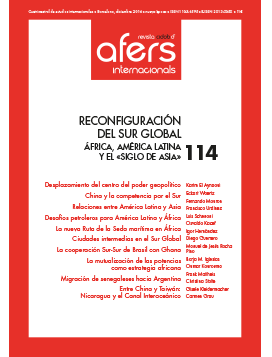Sin espacio para todos: China y la competencia por el Sur
Palabras clave:
China, Brasil, Sudáfrica, liderazgo regional, América del Sur, África AustralResumen
Revista CIDOB d’Afers Internacionals, nº 114
Cuatrimestral (septiembre-diciembre 2016)
ISSN:1133-6595 | E-ISSN:2013-035X
DOI: https://doi.org/10.24241/rcai.2016.114.3.17
Transcurrida más de una década y media del «siglo asiático», el epicentro de la economía mundial se ha trasladado del Atlántico Norte hacia Asia Oriental a un ritmo sin precedentes. Como correlato, la creciente expansión china a nivel global ha ido minando paulatinamente la posición de primeras potencias regionales a países como Brasil y Sudáfrica. El desplazamiento de sus inversiones y la consiguiente pérdida de sus mercados regionales, sumado al crecimiento de otras potencias medias regionales por el fortalecimiento de sus vínculos con Beijing, han empañado las perspectivas de liderazgo regional de ambos países. Desde esta perspectiva, a diferencia de la abundante literatura que apunta a China como la gran oportunidad para estos dos países, en este trabajo se advierte de que tanto Brasil como Sudáfrica han visto mermada su relevancia regional en favor de China, lo que a su vez pone en cuestión la utilidad del concepto BRICS.
Citas
Abdenur, Adriana Erthal y Marcondes de Souza Neto, Danilo. «La creciente influencia de China en el Atlántico Sur». Revista CIDOB d’Afers Internacionals, n.º 102-103 (2013), p. 169-197.
Alden, Chris. China in Africa, Londres: Zed Books, 2007. Armijo, Leslie Elliott. «The BRICs countries (Brazil, Russia, India, and China) as analytical category: mirage or insight?». Asian Perspective, vol. 31, n.º 4 (2007), p. 7-42.
Banco Central do Brasil. Relatório do Banco Central do Brasil. Brasilia: Banco Central do Brasil/Departamento Econômico (Depec), 2010 (en línea) http://www.bcb.gov.br/pec/boletim/banual2010/rel2010p.pdf
Bolt, Jutta y Van Zanden, Jan L. «The Maddison Project: collaborative research on historical national accounts». The Economic History Review, vol. 67, n.º 3 (marzo 2014), p. 627–651.
Brautigam, Deborah. The dragon’s Gift (1ª edición). Nueva York: Oxford University Press, 2009.
Buzan, Barry. «China in International Society: Is ‘Peaceful Rise ‘Possible?». The Chinese Journal of International Politics, vol. 3, n.º 1 (2010), p. 5-36.
Castañeda, Jorge G. «Latin America’s left turn». Foreign Affairs, vol. 85, n.º 3 (2006), p. 28-43.
Cooper, Andrew y Flemes, Daniel. «Foreign policy strategies of emerging powers in a multipolar world: An introductory review». Third World Quarterly, vol. 34, n.º 6 (2013), p. 943-962.
Corkin, Lucy. «Uneasy allies: China’s evolving relations with Angola». Journal of Contemporary African Studies, vol. 29, n.º 2 (2011), p. 169-180.
COSIPLAN-Consejo Suramericano de Infraestructura y Planeamiento. API. Agenda de proyectos prioritarios de integración. Buenos Aires: BID, CAF, Fonplata, 2011 (en línea) http://www.iirsa.org/admin_iirsa_web/Uploads/Documents/api_agenda_proyectos.pdf
Dos Santos, Enestor y Zignago, Soledad. «The emergence of China and the evolution of international trade in Brazil». Integration & Trade Journal, vol. 35, n.º 16 (2012), p. 83-102.
Edwards, Lawrence y Jenkins, Rhys. «The margins of export competition: A new approach to evaluating the impact of China on South African exports to SubSaharan Africa». Journal of Policy Modeling, vol. 36, (2014), p.132-150.
Ferchen, Matt. «China–Latin America relations: long-term boon or short-term boom?». The Chinese Journal of International Politics, vol. 4, n.º 2 (2011), p. 55-86.
Ferchen, Matt. «Whose China Model is it anyway? The contentious search for consensus». Review of International Political Economy, vol. 20, n.º 2 (2013), p. 390-420.
Flemes, Daniel. «Regional power South Africa: Co-operative hegemony constrained by historical legacy». Journal of Contemporary African Studies, vol. 27, n.º 2 (2009), p. 135-157.
Gallagher, Kevin P.; Amos, Irwin y Koleski, Katherine. «The new banks in town: Chinese finance in Latin America». (Febrero de 2012), p. 1-40 (en línea) [Fecha de consulta 12.8.2015] http://ase.tufts.edu/gdae/Pubs/rp/GallagherChineseFinanceLatinAmerica.pdf
Grassi, Sergio. «China and Africa, the ‘Growth Continent’». Journal of Social Democracy, vol. 3 (2013), p. 27-32.
Harsh, Pant. «The BRICS fallacy». The Washington Quarterly, vol.36, n.º 3 (2013), p. 91-105.
Huntington, Samuel. «The lonely superpower (US military and cultural hegemony resented by other powers)». Foreign Affairs, vol. 78, n.º 2 (1999), p. 35 49.
IBGE-Instituto Brasileiro de Geografia e Estatística. «Censo 2010». Río de Janeiro, 2010 (en línea) http://censo2010.ibge.gov.br/resultados/resumo.html
Jenkins, Rhys. «Chinese competition and Brazilian exports of manufactures». Oxford Development Studies, vol. 42, n.º 3 (2014), p. 395-418.
Kaplan, Robert D. Asia’s Cauldron: The South China Sea and the End of a Stable Pacific. Nueva York: Random House, 2014.
Lake, David. «Regional Security Complexes: A Systems Approach», en: Lake, David y Morgan, Patrick (eds.). Regional Orders, Building Security in a New World. University Park, PA: Pennsylvania State University,1997, P. 45-67.
Landsberg, Chris. «The Concentric Circles of South Africa’s Foreign Policy under Jacob Zuma». India Quarterly, vol. 70, n.º 2 (2014), p. 153-172.
Len, Christopher. «China’s 21st Century Maritime Silk Road Initiative, Energy Security and SLOC Access». Maritime Affairs: Journal of the National Maritime Foundation of India, vol. 11 (2015), p. 1-18.
Narlikar, Amrita. New Powers: How to become one and how to manage them. Nueva York: Oxford University Press, 2010.
Nathan, Laurie. Community of Insecurity: SADC’s struggle for peace and security in southern Africa. Londres: Ashgate, 2012.
Pant, Harsh. «The BRICS fallacy». The Washington Quarterly, vol. 36, n.º 3 (2013), p. 91-105.
Pinheiro, Leticia y Gaio, Gabrieli. «Cooperation for Development, Brazilian Regional Leadership and Global Protagonism». Brazilian Political Science Review, vol. 8, n.º 2 (2014), p. 8-30.
Saraiva, Miriam Gomes. «Brazilian foreign policy towards South America during the Lula Administration: caught between South America and Mercosur». Revista Brasileira de Política Internacional, vol. 53, n.º especial (2010), p. 151-168.
Schenoni, Luis. «Unveiling the South American Balance». Estudos Internacionais, vol. 2, n.º 2 (2014), p. 215-232.
Schweller, Randall. «Unanswered Threats: A Neoclassical Realist Theory of Underbalancing». International Security, vol. 29, n.º 2 (2004), p. 159-201.
Shambaugh, David (ed.). Tangled Titans: The United States and China. Blue Ridge Summit, PA: Rowman & Littlefield Publishers, 2012.
Shaw, Timothy. «African agency? Africa, South Africa and the BRICS». International Politics, vol. 52, n.º 2 (2015), p. 255-268.
Sheldon, Garth y Kabemba, Claude (eds.). Win-Win Partnership? China, Southern Africa and extractive industries. Johannesburg: Southern Africa Resource Watch, 2012.
Singer, Paul I. «El “milagro brasileño”: causas y consecuencias». El Trimestre Económico, vol. 40, n.º 160 (1973), p. 753-819.
Singer, J. David; Bremer, Stuart y Stuckey, John. «Capability Distribution, Uncertainty, and Major Power War, 1820-1965», en: Russett Bruce (ed.). Peace, War, and Numbers. Beverly Hills: Sage, 1972, p. 19-48.
Stein, Arthur y Lobell, Steve. «The End of the Cold War and the Regionalization of International Security», en: Lake, David y Morgan, Patrick (eds.). Regional Orders, Building Security in a New World. University Park, PA: Pennsylvania State University, 1997, p. 101-122.
Strüver, Georg. «‘Bereft of Friends’? China’s Rise and Search for Political Partners in South America». Chinese Journal of International Politics, vol. ,7 n.º 1 (2014), p.117-151.
The Economist (2014). «Step Change» (12 de abril de 2014) (en línea) [Fecha de consulta 10.9.2010] http://www.economist.com/news/finance-andeconomics/21600734-revised-figures-show-nigeria-africas-largest-economy-stepchange
Tokatlian, Juan Gabriel. «Crisis y redistribución del poder mundial». Revista CIDOB d’Afers Internacionals, n.º 100 (2012), p. 25-41.
Urdinez, Francisco y Masiero, Gilmar. «China and the WTO: Will the Market Economy Status make any difference after 2016?». Chinese Economy, vol. 48, n.º2 (2015), p. 155-172.
Urdinez, Francisco; Mourón, Fernando; Schenoni, Luis Leandro y Nunes de Oliveira, Amâncio Jorge. «Chinese Economic Statecraft and US Hegemony in Latin America: An Empirical Analysis, 2003–2014». Latin American Politics and Society, vol. 58, n.º 4 (2016), p. 3-30.
White, Hugh. «Power shift: rethinking Australia’s place in the Asian century». Australian Journal of International Affairs, vol. 65, n.º 1 (2011), p. 81-93.
Woertz, Eckart; Pradhan, Samir; Biberovic, Nermina y Jingzhong, Chan. «Potential for GCC agro-investments in Africa and Central Asia». GRC Report, Dubai (2008).
Wohlforth, William. «The stability of a unipolar world». International Security, vol. 24, n.º 1 (1999), p. 5-41.
Yergin, Daniel. «Ensuring energy security». Foreign Affairs, vol. 85, n.º 2 (2006), p.69-82.













